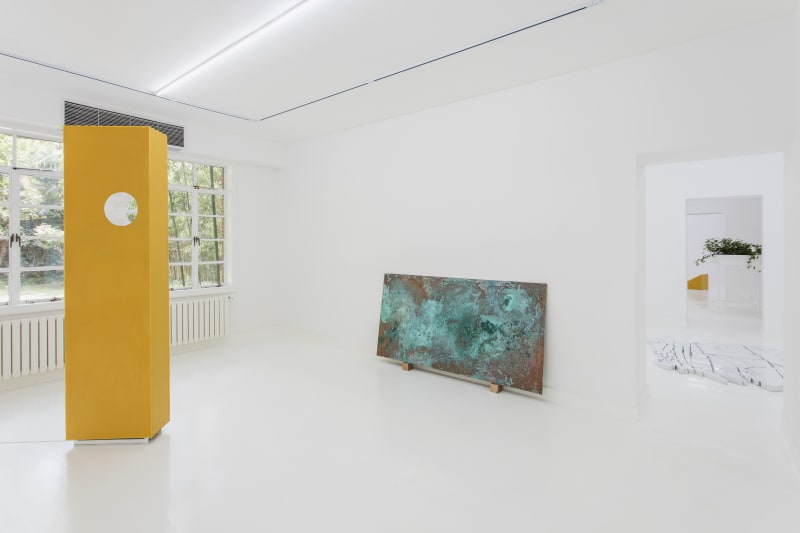The first thing one notices about Alice Wang’s exhibition at CAPSULE is the way her work subtly incorporates the space. The gallery—a combination exhibition space and art laboratory—occupies a lush 1930s garden house brilliantly redesigned by the architect Nunzia Carbone. Quietly hidden at the end of a winding alley, the gallery is filled with light and connects the outdoor green space to the interior through large leaded windows. Just as the gallery has a porous relationship with the environs that surround it, Wang’s work seems to mold to the features of the space.
The first piece that greets viewers is a large raised white flowerpot filled with mimosa pudica, a plant sensitive to movement that recoils and folds its leaves protectively inward when touched. The work does not announce itself immediately and could be as easily an extension of the garden outside as it is part of the exhibition. But it is the plant’s awareness of us rather than our awareness of it that is so uncanny—its slight movements as we unwittingly brush against it in passing, oblivious to its reaction. The exhibition includes a video installation (with Ben Tong) entitled Oracle (2017), a moody array of landscapes and organisms, but otherwise all the works are untitled, which gives them an additional sense of interiority; they are not here for us but for themselves, acting on their own.
There are works that are less delicate but no less potent as the mimosa pudica planter. A sliver of moss seemingly forced up through the floor like a tiny mountain edges towards the window, an escape measured on a tectonic clock. It is a work that plays off the stark white interior of the gallery and the dense sylvan world outside. In another piece, a large copper plate leaning against a wall transforms more rapidly, its colours altered by long streaks of condensation that form images like gas clouds or otherworldly topographies, patterns of bright, satisfying greens held on a deep earthen surface of the copper. The plate reacts to the mixture of late summer humidity, the rush of cool, conditioned air, and the presence of viewers in the space. The work shares visual echoes with Andy Warhol’s Oxidation Paintings (1977–78), his playful commentary on abstract expressionism spoken in splatters of urine, but Wang’s work is not tongue-in-cheek. The copper is an organism adapting and reinventing itself in this ever-changing milieu. It is safe to say that change in these works is key. In another visually striking piece, a cluster of fossilized clamshells gilded in silver is arranged in an amoeba-like pattern on the floor. It is impossible not to notice the lustre of the silver fading, untouched but unprotected and thus subject to tarnish and decay. Over time, the fossils will eventually turn black. While each has a fierce presence, each is also a chrysalis waiting to reveal some new form.
There are two pieces that assert themselves more than others: the first, a triangular wedge of beeswax and water vapour, and the second, a towering slab of beeswax with a hole lined in silver. The triangular wedge, connected to the wall by an electrical cord, has dozens of perforations laid out in a symmetrical pattern from which a fog of vapour emerges. For a moment, the vapour is suspended, and then falls over the sides and disappears. The wedge is small but is just as imposing as the tall slab of beeswax, also tethered to the wall by an electrical cord, which emanates a mechanical whirling sound but seems to do nothing in particular, either cooling or melting the piece, or perhaps concealing some secret labour. The beeswax constructions feel meditative but refuse the spiritualism of aesthetically similar works by artists like Wolfgang Laib, which are not about the substances themselves but the way substances are taken up as a symbol by both artist and viewer. Wang instead exposes the ontology of substance brought forth through the techne of form. The wedge exhales vapours and the slab hums with inner life. Alice Wang produces works that are animated by their own chemistries and that enfold their surroundings. These are works that transform and mutate; metamorphic works that respond to the worlds they encounter to become something new.



